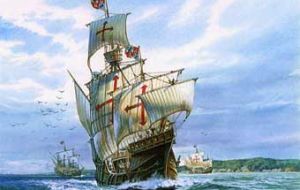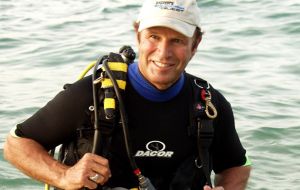MercoPress. South Atlantic News Agency
Discovery of the century: is it the wreckage of Columbus 'Santa María'?
 The “Santa Maria” accidentally ran aground off the coast of what is now Haiti on Christmas Day in 1492
The “Santa Maria” accidentally ran aground off the coast of what is now Haiti on Christmas Day in 1492  Explorer Clifford used data from a 2003 expedition as well as information from Columbus' own journals
Explorer Clifford used data from a 2003 expedition as well as information from Columbus' own journals Archaeologists believe they may have found the wreckage of the Santa Maria, one of the ships Christopher Columbus used to sail the ocean blue en route to the “New World” more than 500 years ago.
The wreck was discovered stuck on a reef at the bottom of the sea off the north coast of Haiti in the exact spot Columbus reported losing his flagship.
As it is known, Columbus took three ships on his famous voyage from Spain to "discover" America in the 15th century: the Niña, the Pinta and the Santa Maria. But what is not much remembered is that two of them: the Niña and Pinta made it back to Spain. The Santa Maria did not.
Instead, it accidentally ran aground off the coast of what is now Haiti on Christmas Day in 1492. Crews used wooden planks and other provisions from the 117-foot-long ship to help build a fort on the island.
The rest sank into the depths of the ocean. So how did archaeologists supposedly find its remains centuries later?
Explorer Barry Clifford used data from a 2003 expedition to the area as well as information from Columbus' own journals to locate what he believes is the famous wreckage.
The "smoking gun" he says, is a cannon of 15th century design found at the site. The ship is also the right size, and stones found nearby match those from the area of Spain where the ship was built.
"It is the Mount Everest of shipwrecks for me," the 68-year-old Clifford told CNN. "This ship changed the course of human history."
The plan now is to excavate the wreck with the help of the Haitian government and examine it before putting the ship on display in a local museum. If confirmed, it would be one of the most significant underwater archaeological finds in recent history.
Spain's King Ferdinand II and Queen Isabella I sent Columbus on his famous voyage in hopes of finding a westward route to China, India and islands to the east that were home to gold and spices.
But the land he set eyes on in October 1492 wasn't India, but the present-day Bahamas.
Celebrated for centuries as the "discoverer of America," Columbus is also reviled by many for opening up the Americas to European colonization and, as a result, the destruction of the native peoples on the islands he explored.
He also didn't really "discover America." Researchers now believe Viking Leif Ericksson beat him to the punch nearly 500 years earlier.




Top Comments
Disclaimer & comment rules-

-

-

Read all commentsIt is a pity that Columbus should bear the blame for the total disappearance of the native population of the Caribbean Islands - blame should be directed at the greed of the conquistadores sent in his wake together with the actions of the Catholic Church.
May 14th, 2014 - 03:28 pm 0I thought it was a established fact Leif Ericksson had discovered the continent 500 years before columbus by now and that at the same time in history Polinesians had arrived in California and Southern Chile.
May 14th, 2014 - 04:27 pm 0I personally believe they brought over Araucana chickens whose genes are found today in patagonian chickens which are resulted of the crossing with European chickens with a local one which has gone extinct now. Its just the genes that codify for the blue and green colored eggs that remain.
http://www.youtube.com/watch?v=yunmUCuoMWA
As well as sweet potato that has being cultivated in the Pacific pre colombian times
@2
May 14th, 2014 - 05:06 pm 0“He also didn't really “discover America.” Researchers now believe Viking Leif Ericksson beat him to the punch nearly 500 years earlier.”
What a strange ending. It's as though the author has only just heard about it and stuck it in last minute.
The DNA is very interesting. I did not know about the chickens.......
Commenting for this story is now closed.
If you have a Facebook account, become a fan and comment on our Facebook Page!